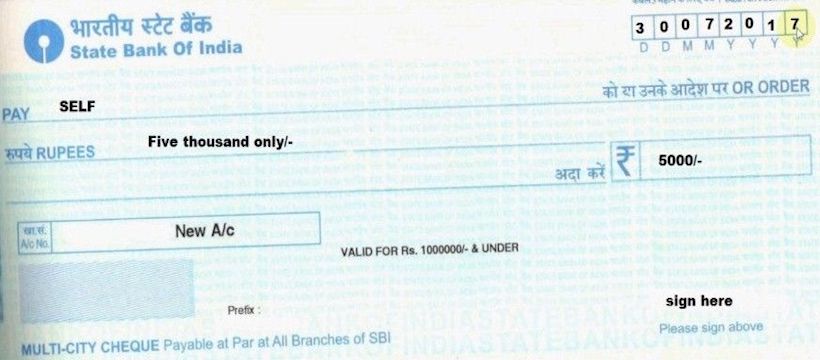Cheque: Although forms of cheques have been in use since ancient times and at least since the 9th century, it was during the 21st century that cheques became a highly popular non-cash method for making payments and the usage of cheques peaked. By the second half of the 21st century, as cheque processing became automated, billions of cheques were issued annually; these volumes peaked in or around the early 1990s.
Since then cheque usage has fallen, being partly replaced by electronic payment systems. In some countries like Poland cheques have become a marginal payment system or have been phased out completely.
Quick Links
Meaning :
A cheque is a document that orders a payment of money from a bank account. The person writing the cheque, the drawer, usually has an account where their money was previously deposited. The drawer writes the various details including the monetary amount, date, and a payee on the cheque, and signs it, ordering their bank, known as the drawee, to pay that person or company the amount of money stated. Cheques are a type of bill of exchange and were developed as a way to make payments without the need to carry large amounts of money.

While paper money evolved from promissory notes, another form of negotiable instrument, similar to cheques in that they were originally a written order to pay the given amount to whoever had it in their possession. Technically, a cheque is a negotiable instrument instructing a financial institution to pay a specific amount of a specific currency from a specified transactional account held in the drawer’s name with that institution.
Both the drawer and payee may be natural persons or legal entities. Specifically, cheques are order instruments, and are not in general payable simply to the bearer (as bearer instruments are) but must be paid to the payee. In some countries, such as the US, the payee may endorse the cheque, allowing them to specify a third party to whom it should be paid.
Characteristics of Cheque
Instrument in Writing : A cheque must be an instrument in writing. Oral orders, although they may have the other requisites, cannot be treated as cheques. It may be in any language and in any form. It may be written in ink or pencil or may even be printed or cyclostyled. It may be in any form, but the words must be visible.
Unconditional Order : Cheque must contain definite and an unconditional order to pay. A conditional instrument is invalid. For instance, if the cheque has a receipt form attached to it and the following words are added, “provided the receipt form at the foot is duly signed and dated,” or if the amount is made payable out of a particular fund, the order will be regarded as conditional and hence the instrument containing such a direction cannot be regarded as a cheque.
On a Specified Banker Only : The instrument must be drawn on a specified banker. This means, firstly, that it should be drawn on a banker and not on any other person. Secondly the name and preferably also the address of the banker should be specified.
Certain Sum of Money Only : The order must be only for the payment of a certain sum of money only. It is clear that orders asking the banker to deliver securities or certain other things cannot be regarded as cheque. It must also be noted that the sum of money to be paid must be certain.
Amount of Cheque : It is necessary to mention clearly the amount of money which the drawer desires his banker to pay. The sum is usually stated in words as well as in figures so as to avoid mistakes. No blank space should be left on the cheque before and after the amount stated in words and in figures.
Payee to be Certain : In order that an instrument shall be a valid cheque, it should be made payable to or to the order of a certain person or the bearer. The payee must be certain.
Signature : The cheque must be signed by the drawer
Parties to a Cheque
Here are three parties involved in a cheque. They are as follows:
Drawer : Drawer is the party who draws the cheque upon a soecified banker. He is the maker of the cheque. He is the account holder who draws the cheque for drawing money from his bank account. He is the person who issues cheque directing the bank to pay a certain sum of money to a certain person or to the bearer. Thus, the person who signs the cheque is known as drawer.
Drawee : Drawee is the party upon whom the cheque is drawn. Drawee is the bank. It is the party to whom the drawer gives order to pay the amount to the person named on the cheque or his order to the bearer. When the bank follows the order and pays the amount of the che-que then the cheque is said to be honored. In case of refusal of the order, the cheque is said to be dishonored.
Payee : Payee is the party who presents the cheque for payment. He is the person who receives money from bank. He is the party in favour of whom cheque is issued. The payee is the person whose name is mentioned on the cheque. If the cheque is made payable to self, the drawer himself becomes the payee
Recommended Articles

